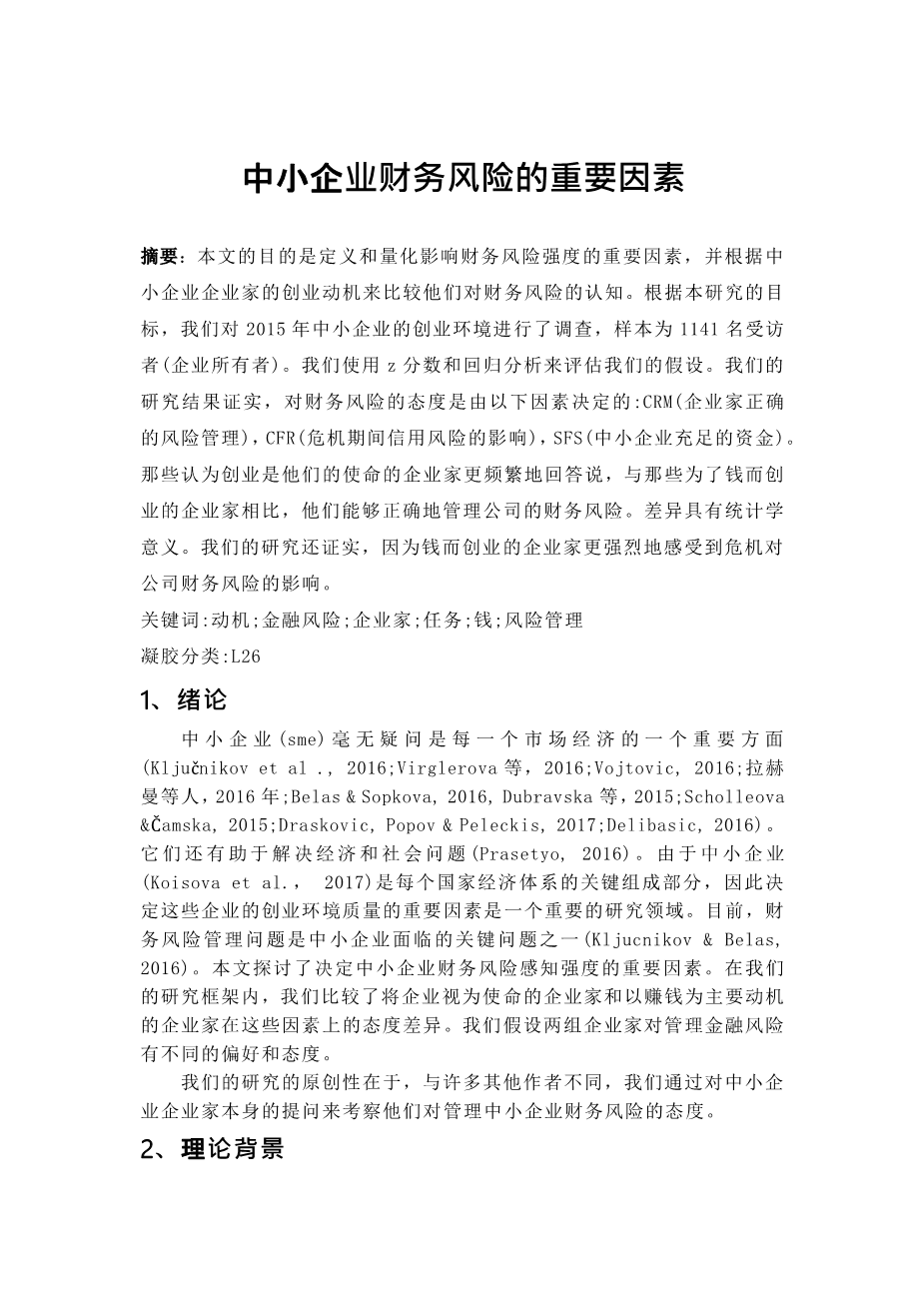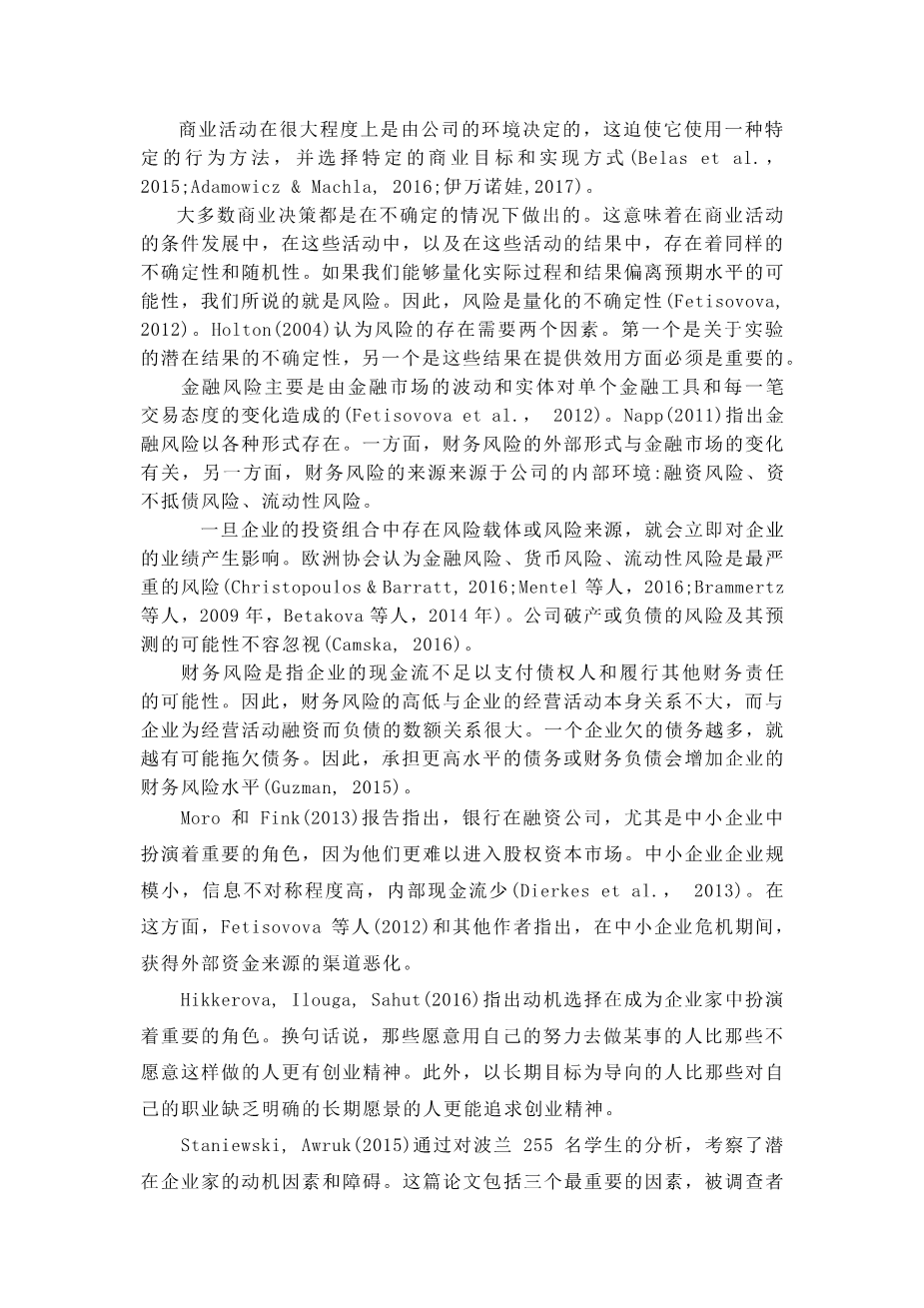Belaacute;s, J., Dvorskyacute;, J., Kubaacute;lek, J., amp; Smrčka, L. (2018). Important factors of financial risk in the SME segment. Journal of International Studies, 11(1), 80-92. doi:10.14254/2071-8330.2018/11-1/6
Important factors of financial risk in the SME segment
Jaroslav Belaacute;s
Faculty of Management and Economics, Tomas Bata University in Zliacute;n, Czech Republic
Jaacute;n Dvorskyacute;
Faculty of Management and Economics, Tomas Bata University in Zliacute;n, Czech Republic
Jaacute;n Kubaacute;lek
Department of Business Economics, University of Economics Praha, Czech Republic
Luboscaron; Smrčka
Department of Business Economics, University of Economics Praha, Czech Republic
Abstract. The aim of the article is to define and quantify the significant factors which influence the intensity of financial risk, and to compare the perception of financial risk among groups of entrepreneurs in the SME segment according to their motivations for starting a business. In relation with the aims defined under this research, we carried out a survey of the entrepreneurial environment of SMEs in 2015, using a sample of 1,141 respondents (the owners of the enterprises). We used Z-score and regression analysis to assess our hypotheses. The results of our research confirmed that the attitude towards financial risk is determined by the following factors: CRM (Correct risk management by entrepreneurs), CFR (The influence of credit risk during a crisis), and SFS (Sufficient funds for SMEs). The entrepreneurs who started their business because they considered it to be their mission answered more frequently that they can correctly manage financial risk in their companies in comparison with the entrepreneurs who started their business for money. The difference was statistically significant. Our research also confirmed that entrepreneurs who started their business because of money perceived the effects of crisis on their companyrsquo;s financial risk more intensely.
Keywords: motivation; financial risk; entrepreneur; mission; money; risk management
JEL Classification: L26
- INTRODUCTION
Small and medium-sized enterprises (SMEs) are without a doubt an essential aspect of every market economy (Ključnikov et al., 2016; Virglerovaacute; et al., 2016; Vojtovic, 2016; Rahman, et al., 2016; Belaacute;s amp; Sopkovaacute;, 2016, Duacute;bravskaacute; et al., 2015; Scholleovaacute; amp; Čaacute;mskaacute;, 2015; Draskovic, Popov amp; Peleckis, 2017; Delibasic, 2016). They contribute also to the solution of economic and social state problems (Prasetyo, 2016).
Since the SMEs (Koisova et al., 2017) are a key part of every countryrsquo;s economic system, the important factors determining the quality of the entrepreneurial environment of such companies are a vital area of research.
Currently, the issue of financial risk management is among one of the crucial problems for SMEs (Kljucnikov amp; Belas, 2016). The present article explores the important factors determining the intensity of perceived financial risk in the segment of SMEs. Within the framework of our research we compare the differences in the attitude to those factors between entrepreneurs who see their business as a mission and entrepreneurs whose main motive for doing business is making money. We suppose that either group of entrepreneurs has different preferences and attitudes towards managing financial risk.
The originality of our research consists in the fact that, unlike many other authors, we examine the attitude towards managing financial risk in the segment of SMEs by questioning the entrepreneurs themselves.
- THEORETICAL BACKGROUND
Business activities are significantly determined by the environment of the company, which forces it to use a particular method of behaviour and to choose particular business goals and ways of achieving them (Belaacute;s et al., 2015; Adamowicz amp; Machla, 2016; Ivanovaacute;, 2017).
Most business decisions are made in conditions of uncertainty. This means that there is the same uncertainty and randomness in the development of conditions for business activities, during these activities, and the outcome thereof. If we are able to quantify the likelihood of diversion of actual processes and outcomes from the expected level, we speak of risk. Risk is therefore quantified uncertainty (Fetisovovaacute;, 2012). Holton (2004) argues that there are two ingredients that are needed for risk to exist. The first is uncertainty about the potential outcomes of an experiment and the other is that the outcomes have to matter in terms of providing utility.
Financial risk is mainly caused by the movements in financial markets and changing attitudes of entities to the individual financial tools and in each transaction (Fetisovovaacute; et al., 2012). Napp (2011) states that financial risk exists in various forms. On the one hand, there are external forms of financial risk connected with the changes on financial markets, on the other hand, there are sources of financial risk originating in the companyrsquo;s internal environment: financing risk, insolvency risk, and liquidity risk.
The impact on the results of an enterprise is immediate as soon as there is a carrier or source of risk in the portfolio of the enterprise. The European society views financial risk, currency risk, liquidity risk as the most serious risks (Christopoulos amp; Barratt, 2016; Mentel et
剩余内容已隐藏,支付完成后下载完整资料


英语译文共 16 页,剩余内容已隐藏,支付完成后下载完整资料
资料编号:[607212],资料为PDF文档或Word文档,PDF文档可免费转换为Word
课题毕业论文、文献综述、任务书、外文翻译、程序设计、图纸设计等资料可联系客服协助查找。


